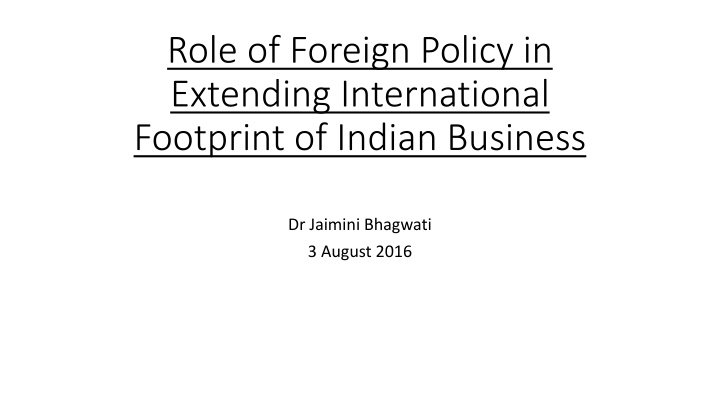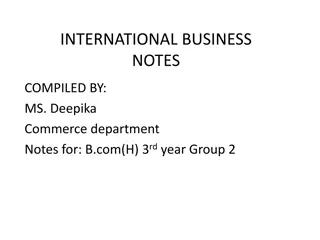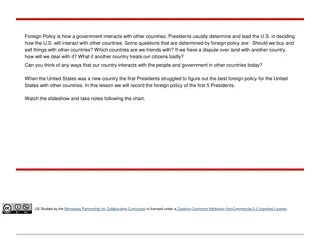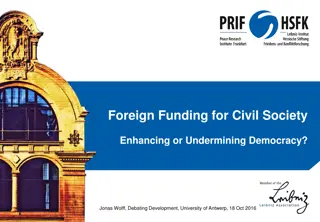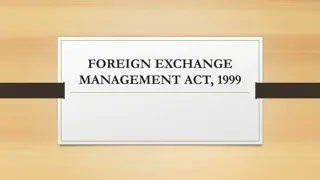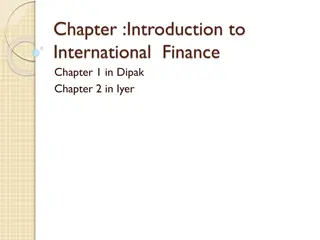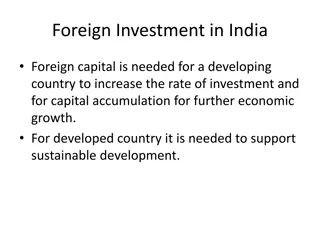Role of Foreign Policy in Extending International Footprint of Indian Business
Economic diplomacy plays a crucial role in India's foreign policy, with a focus on partnerships with the private sector, engagement with multilateral bodies and trade agreements, and bilateral trade relationships with key countries. Dr. Jaimini Bhagwati discusses the impact of foreign policy on India's business expansion in the global market, highlighting strategies and collaborations that have shaped India's international presence.
Download Presentation

Please find below an Image/Link to download the presentation.
The content on the website is provided AS IS for your information and personal use only. It may not be sold, licensed, or shared on other websites without obtaining consent from the author.If you encounter any issues during the download, it is possible that the publisher has removed the file from their server.
You are allowed to download the files provided on this website for personal or commercial use, subject to the condition that they are used lawfully. All files are the property of their respective owners.
The content on the website is provided AS IS for your information and personal use only. It may not be sold, licensed, or shared on other websites without obtaining consent from the author.
E N D
Presentation Transcript
Role of Foreign Policy in Extending International Footprint of Indian Business Dr Jaimini Bhagwati 3 August 2016
Economic Diplomacy Economic diplomacy has always been integral to India s foreign policy After the game changing industrial and import delicensing economic reforms plus devaluation of the Rupee post 1991 when Narasimha Rao was PM a more conscious approach was taken
Partnership with Private Sector India s private sector has lobbied for government to push its cause with international trading and investment (FDI and portfolio investment) partners For example, Confederation of Indian Industry (CII) and FICCI have sought the Indian government s support in engagement with/through the Indian diaspora and development cooperation programmes e.g. in Africa, South and Central Asia
Multilateral Bodies & Trade Agreements Ministry of External Affairs and the nodal Ministries concerned have strengthened aid and lending linkages and engagement with and via the World Bank, IMF, AIIB, BRICS New Development Bank, G 20 and SAARC Additionally a number of bilateral and multilateral trade agreements have been signed e.g. with Sri Lanka, ASEAN, Afghanistan and Chile
Bilateral Trade in Goods* (US$ billions) 2014 *Goods exports of country in top most row to country in extreme left column Source: UNCTAD India - 45.2 16.4 7.4 26.7 USA 22.5 - 159.8 74.4 79 China 59.6 466.7 - 181.7 224.2 Japan 9.6 134 162.8 - 104.5 ASEAN 46.8 147.5 208.2 116.7 - India USA China Japan ASEAN
Bilateral Trade in Goods 2014 (Contd.) In 2014 India s two-way trade in goods with the US (India s exports of $45.2 billion plus US exports to India of $22 billion) was 10.8 per cent of China s trade with the US (China s exports of $466.7 billion and US exports to China of $159.8 billion). Similarly, in 2014 India s two-way trade with Japan was a mere 4.9 per cent of China s trade with Japan Why is the European Union not mentioned?
Two-way Bilateral Trade as percentage of Total Trade 2014 Two-way trade of country in top most row with country in extreme left column as a percentage of top row country s global trade Source: UNCTAD India - 8.7 9.7 2.2 9.4 USA 1.7 - 16 5.3 5.7 China 1.7 13.7 - 7.5 9.5 Japan 1.1 13.1 21.6 - 13.9 ASEAN 2.9 8.8 16.8 8.6 - India USA China Japan ASEAN
Two-way Bilateral Trade as percentage of Total Trade 2014 (Contd.) India s two-way trade with China was 9.7 per cent of India s total global trade while India accounted for only 1.7 per cent of China s global trade Bilateral trade for USA, Japan and ASEAN with China is a larger fraction of their global trade than the corresponding numbers for China
Energy Security The priority accorded to Energy Security has resulted in ONGC-OVL making investments in countries such as Sudan, Iran, Nigeria and Kazakhstan Civil nuclear power cooperation has been given importance and the Soviet Union later Russia has been a partner in building two nuclear power plants in Kudankulam of 1000 Mw each. Four more are to be built The diplomatic initiative with the US led to the 123 Agreement between India and the US and opened the door for civil nuclear cooperation with other NSG members as well
Building & Sharing Infrastructure Hydro-electric power projects in Bhutan and possibly in Nepal Purchase/Sale of power relationships with Bangladesh maybe even Pakistan at some time in the future
Building & Sharing Infrastructure (contd.) Construction of roads and possibly waterway and rail linkages with Bangladesh, Myanmar as part of Act-East
Coordination within Government Australia and Brazil are two G20 countries which have merged their External Affairs and Foreign Trade Ministries In the Indian Government there is a tendency for government departments to work in silos
Coordination within Government (contd.) Lack of adequate working relationship between MEA and DIPP in MoCI meant that the Bengaluru Mumbai Industrial Corridor project did not even start Long gestation mega initiatives involving alignment of rail tracks with roads, technology parks, urbanization, roads, bridges, power plants would be undertaken in India with foreign participation or in India s neighbourhood with our support with a greater sense of urgency if coordination within GoI were better
Coordination within Government (contd.) Ministry of Commerce is responsible for trade policy while MEA is accountable for foreign policy Ministry of Finance is the nodal ministry for multilateral development banks, IMF and AIIB
Recent Initiatives NDA government has vigorously chalked up significant foreign policy successes since May 2014 Furious pace of trips by PM to countries which have not been ever visited by an Indian head of government or in several decades Visits aimed at addressing security and strategic concerns and major thrust area include trade, FDI and technology transfer
Recent Initiatives (contd.) Need to follow up domestically through better inter-Ministerial coordination and with state governments on the multiple opportunities for economic engagement which have opened up Huge opportunity costs of not adequately following up domestically on recent breakthroughs
Recent Initiatives (contd.) Remarkable energy and outreach to NRI communities including the issues of OCI/PIO and visas will be helpful Raising of FDI limits e.g. in sectors such as defence, insurance and for Asset Reconstruction Companies (ARCs) have created a positive environment for foreign investments
MEA Staff Issues Raising of officer strength in MEA in Delhi in the next few years even as we wait for staff to grow over time with higher levels of initial recruitment
Inter-Ministerial Coordination Inter-ministerial coordination is important plus restructuring is needed too Fold MOIA into MEA Merge MEA and Ministry of Commerce & Industry
Conclusion UPA-I and II governments between 2004 and 2014 were faulted less for foreign policy failures more for so called scams and little forward movement in economic reforms Non-visits to neighbouring and other significant countries was glaring but system wide policy paralysis in economic decision making was highly damaging even though there was forward movement on some foreign relations fronts e.g. 123 Agreement with the US
Conclusion (contd.) India at its present stage of economic diplomacy and its active and even flawless implementation is a superstructure on domestic security, economic and social development related progress Appetite of all foreign countries significant or otherwise to engage with India will be impacted by their perceptions of the current and potential state of our external security, internal stability and social, health and economic indicators too
